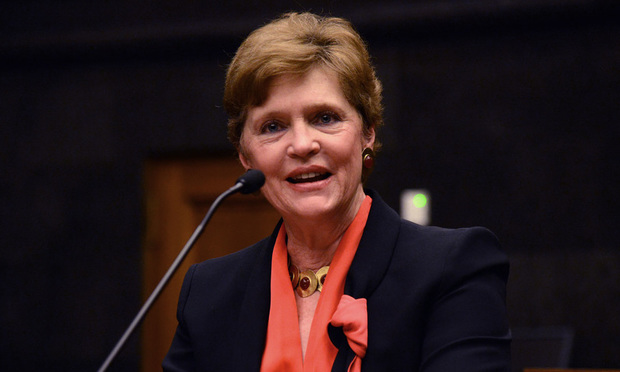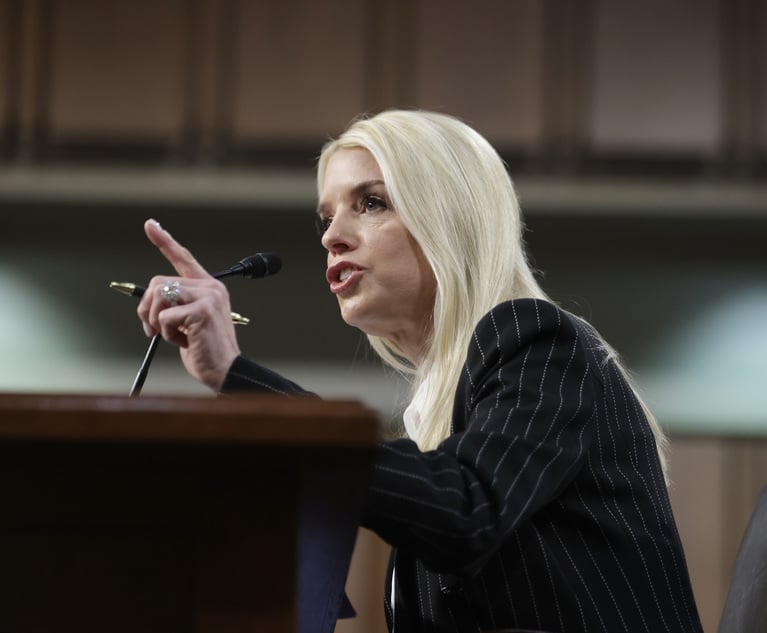'It Will Look Different': SDNY's Phased Reopening to Include 'Physical Changes,' Continued Remote Hearings
Chief Judge Colleen McMahon said she would implement social-distancing measures at the Southern District's Lower Manhattan courthouse,
May 19, 2020 at 04:07 PM
4 minute read
 Chief Judge Colleen McMahon of the U.S. District Court for the Southern District of New York.
Chief Judge Colleen McMahon of the U.S. District Court for the Southern District of New York.
A phased reopening of the U.S. District Court for the Southern District of New York would feature the continued use of remote hearings and significant "physical changes" to implement social-distancing measures at its Lower Manhattan courthouse, Chief Judge Colleen McMahon told the Law Journal on Tuesday.
McMahon, who spoke from her chambers via Skype for Business, said there was still no date set for restoring in-person court operations, and any reopening would be "very gradual," relying partly on input from public health experts and the court's own outside scientific consultant.
She also said jury trials in the building were "not imminent."
Court staff would return to the building first in smaller numbers than usual and at a staggered schedule. On any given day, McMahon said, about half of the court's staff would be present at the Foley Square facility.
McMahon said that jury trials were still a ways off, though other types of public proceedings could resume in the interim. However, attorneys can expect to encounter a courthouse much changed from the days prior to the COVID-19 pandemic.
"It will look different," she said.
For instance, McMahon said, the court plans to have a guard posted at the doors to take temperatures and ask screening questions of those looking to gain entry. There would also be decals on the floor indicating safe distances at which visitors will be allowed to stand.
The court was also reconfiguring its largest courtrooms in the Daniel Patrick Moynihan Courthouse and the Thurgood Marshall Courthouse just across Pearl Street. There would be fewer attorneys permitted in the well, and the gallery would be "clearly marked" to indicate where people would be allowed to sit.
The court, McMahon said, would likely continue call-in access to live proceedings and was considering expanded use of overflow rooms. All participants would be required to wear masks, and podiums would be disinfected in between speakers.
When jury trials finally do resume, jurors would be seated in expanded jury boxes, with physical partitions and video for those who are forced to sit farther away from witnesses. The court would need to call greater numbers of potential jurors with at least a four-week lead time, McMahon said.
Even then, McMahon said, she expected that much of the court's work to be done remotely, as it has throughout the public health crisis.
"There will be fewer lawyers flying in from all over the country. We've learned a lot through this process," she said. "I do expect a lot more remote work to be done."
With the Southern District facing a growing backlog of criminal proceedings, McMahon said she was also encouraging judges to consider conducting bench trials in civil cases.
McMahon, who has served as chief judge since 2016, said she takes issue with the term "reopening" because, while the court was forced in March to close its doors to the public, urgent criminal matters, such as arraignments, bail applications and reviews, have proceeded. Judges have continued to manage their dockets remotely using teleconference and video calls, and McMahon noted, they had published more than 11,900 orders between March 16 and April 30.
A team led by District Executive Edward Friedland had been vital to developing and implementing new protocols to guide the reopening process, including a forthcoming set of rules that would be posted soon to the Southern District's website.
"They have not stopped, and they have done an amazing job," McMahon said. "It's really been a team effort."
McMahon said she was aware of warnings from experts that there could be a new spike COVID-19 cases this fall and was factoring that possibility into her reopening plans. If the Southern District were to resume jury trials too soon, she said, it ran the risk of ending up in the "same position" as it found itself in March.
"It's going to be a week-by-week evaluation, reevaluation," she said. "There's just no way to predict."
READ MORE:
McMahon Says No Plans to Reopen SDNY Courthouse After Judge Floats In-Person Hearing
SDNY Tightens Restrictions on Use of Manhattan Courthouses in Response to Coronavirus
2nd Circuit to Weigh Reopening In-Person Operations in Summer, Katzmann Says
NOT FOR REPRINT
© 2025 ALM Global, LLC, All Rights Reserved. Request academic re-use from www.copyright.com. All other uses, submit a request to [email protected]. For more information visit Asset & Logo Licensing.
You Might Like
View All

Read the Document: DOJ Releases Ex-Special Counsel's Report Explaining Trump Prosecutions
3 minute read
After Solving Problems for Presidents, Ron Klain Now Applying Legal Prowess to Helping Airbnb Overturn NYC Ban
7 minute read
US Courts Announce Closures in Observance of Jimmy Carter National Mourning Day
2 minute readTrending Stories
- 1'A Death Sentence for TikTok'?: Litigators and Experts Weigh Impact of Potential Ban on Creators and Data Privacy
- 2Bribery Case Against Former Lt. Gov. Brian Benjamin Is Dropped
- 3‘Extremely Disturbing’: AI Firms Face Class Action by ‘Taskers’ Exposed to Traumatic Content
- 4State Appeals Court Revives BraunHagey Lawsuit Alleging $4.2M Unlawful Wire to China
- 5Invoking Trump, AG Bonta Reminds Lawyers of Duties to Noncitizens in Plea Dealing
Who Got The Work
J. Brugh Lower of Gibbons has entered an appearance for industrial equipment supplier Devco Corporation in a pending trademark infringement lawsuit. The suit, accusing the defendant of selling knock-off Graco products, was filed Dec. 18 in New Jersey District Court by Rivkin Radler on behalf of Graco Inc. and Graco Minnesota. The case, assigned to U.S. District Judge Zahid N. Quraishi, is 3:24-cv-11294, Graco Inc. et al v. Devco Corporation.
Who Got The Work
Rebecca Maller-Stein and Kent A. Yalowitz of Arnold & Porter Kaye Scholer have entered their appearances for Hanaco Venture Capital and its executives, Lior Prosor and David Frankel, in a pending securities lawsuit. The action, filed on Dec. 24 in New York Southern District Court by Zell, Aron & Co. on behalf of Goldeneye Advisors, accuses the defendants of negligently and fraudulently managing the plaintiff's $1 million investment. The case, assigned to U.S. District Judge Vernon S. Broderick, is 1:24-cv-09918, Goldeneye Advisors, LLC v. Hanaco Venture Capital, Ltd. et al.
Who Got The Work
Attorneys from A&O Shearman has stepped in as defense counsel for Toronto-Dominion Bank and other defendants in a pending securities class action. The suit, filed Dec. 11 in New York Southern District Court by Bleichmar Fonti & Auld, accuses the defendants of concealing the bank's 'pervasive' deficiencies in regards to its compliance with the Bank Secrecy Act and the quality of its anti-money laundering controls. The case, assigned to U.S. District Judge Arun Subramanian, is 1:24-cv-09445, Gonzalez v. The Toronto-Dominion Bank et al.
Who Got The Work
Crown Castle International, a Pennsylvania company providing shared communications infrastructure, has turned to Luke D. Wolf of Gordon Rees Scully Mansukhani to fend off a pending breach-of-contract lawsuit. The court action, filed Nov. 25 in Michigan Eastern District Court by Hooper Hathaway PC on behalf of The Town Residences LLC, accuses Crown Castle of failing to transfer approximately $30,000 in utility payments from T-Mobile in breach of a roof-top lease and assignment agreement. The case, assigned to U.S. District Judge Susan K. Declercq, is 2:24-cv-13131, The Town Residences LLC v. T-Mobile US, Inc. et al.
Who Got The Work
Wilfred P. Coronato and Daniel M. Schwartz of McCarter & English have stepped in as defense counsel to Electrolux Home Products Inc. in a pending product liability lawsuit. The court action, filed Nov. 26 in New York Eastern District Court by Poulos Lopiccolo PC and Nagel Rice LLP on behalf of David Stern, alleges that the defendant's refrigerators’ drawers and shelving repeatedly break and fall apart within months after purchase. The case, assigned to U.S. District Judge Joan M. Azrack, is 2:24-cv-08204, Stern v. Electrolux Home Products, Inc.
Featured Firms
Law Offices of Gary Martin Hays & Associates, P.C.
(470) 294-1674
Law Offices of Mark E. Salomone
(857) 444-6468
Smith & Hassler
(713) 739-1250






